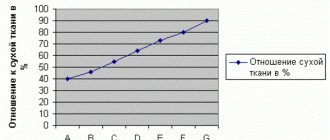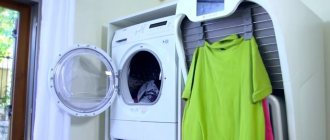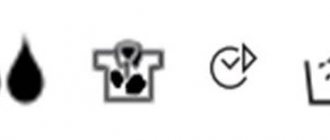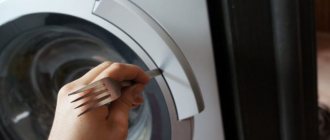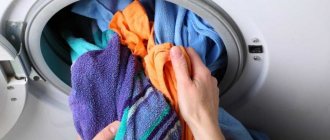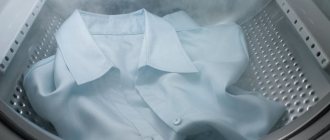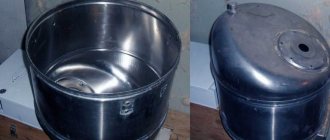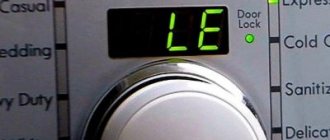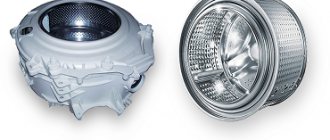When buying a washing machine, you should focus on several basic parameters that determine its class: size and type of load, washing efficiency, spin type and energy efficiency. Knowledge about each of these criteria will ultimately help you choose the optimal model that will serve its owner for many years and will suit him not only visually, but also technically.
- Generally accepted classification
- Why do they give an "A" grade?
- Washing class
- Spin class
- Energy class
- Types by size and loading
- Is drying necessary?
- Additional functions
- What to look for when purchasing
- Catalog of washing machines with reviews
Generally accepted classification
Are you using citric acid?
Oh yes! No
You can understand the quality of the washing machine in front of you by focusing on a special classification developed by European countries. Models of this type of household appliances are evaluated according to three main indicators: energy consumption, washing quality and spin performance.
In all of these parameters there is a gradation by class, where “A” is the highest grade and “G” is the lowest. Each vehicle parameter is assigned 7 ratings:
- “A” and “B” are excellent and good grades, respectively;
- “B” and “C” – very good and not bad;
- “D” and “E” – normal and satisfactory;
- "F" and "G" are bad and very bad.
General classification
It turns out that any machine will receive at least three ratings. The latest options are practically not produced, and it is also unlikely that anyone would want to purchase equipment that is already known to be ineffective. But if, nevertheless, such a model is found on the consumer market, then there is no need to buy it.
It is worth paying attention to the fact that the classification system is only a basis that changes and is modernized over time. Thus, depending on the parameter of energy efficiency and washing, new classes have appeared: “A+”, “A++” and also “A+++”.
Help: determining the class of the selected model is not difficult even for a beginner - this data is located on a special sticker on the body of the machine. Usually the manufacturer does not hide them, but on the contrary, makes them most noticeable.
Energy efficiency of appliances
This indicator is certainly important in washing machines, especially during a constant increase in tariffs. The first tests of energy saving efficiency were calculations of the energy consumed to wash 1 kg of clothes at a temperature of 60 degrees. Over time, the most expensive models were identified from a number of categories (from A to G). They were products of categories “F” and “G”. Instead, new energy efficiency classes appeared - A (+, ++, +++).
When choosing these categories, keep in mind the slight difference in savings between the three-plus and two-plus models. Moreover, the cost of the machines themselves can differ by several thousand. Based on this, we can say that savings on washing do not always pay for the money spent on purchasing a more economical model.
Why do they give an "A" grade?
For any of the parameters (washing efficiency, spinning and energy consumption), a rating of “A” or “very good” is top notch. It is placed if the SMA performs the specified function at a high level:
- Washing class “A” is assigned if the machine removes all stains and is as efficient as possible.
- Spin class “A” is assigned depending on the residual moisture content of the laundry (in this case it should not exceed 45%).
- In terms of energy efficiency, the most economical washing machine in terms of energy consumption receives an “A” rating.
Class A+++
How to choose the right machine according to these characteristics
An expensive thing does not mean the best, but from the cheap ones you can choose an option in which you have the opportunity to win. Production focuses on budget options.
An automatic washing machine of class A may lose the quality of spin class B and C. The difference is that the rotation speed of the drum is too high, and it can damage the laundry.
The machine selection scheme is simple:
- family budget analysis;
- selection of washing and spin classes for washing machines (optimality corresponds to B and C);
- selecting the type of energy consumption (from A+ and above);
- selection of drum diameter (depending on the calculation of the amount of dirty material per cleaning).
Any washing machine has advantages and disadvantages when it comes to the versatility of the equipment. A household machine of any class is designed for a specific type of laundry (fragile, rough, dense, delicate, etc.).
Washing class
One of the main functions of a washing machine is to combat stains on fabric. The efficiency indicator for this parameter just demonstrates the washing class. There is also a generally accepted gradation from “A” (washing is very good) to level “G” (very weak).
A completely logical question arises: why is this or that technique awarded a certain class? Naturally, it is possible to determine how well SMA erases only under experimental conditions. IN
As a starting point, a standard machine is taken, which copes with this no better or worse than others, but always shows a constant result. Under the same conditions, on the same piece of fabric, a test is carried out, based on the results of which a verdict is made:
- The highest score, or “A” rating, is given to a machine whose washing class is defined as excellent (its efficiency index is 1.3).
- Very good wash o (index – from 1 to 1.3).
- A good wash is assigned class “C” (index – from 0.97 to 1).
- Normal is designated by the letter “D” (index – from 0.94 to 0.97).
- Satisfactory is “E” (index – 0.91 to 0.94).
- The bad one gets o (index – from 0.88 to 0.91).
- Very poor washing o (index – 0.88-0).
Expert opinion
I work in the household appliance repair industry. Extensive experience in restoring washing machines and dishwashers.
Ask a Question
Important! Today, manufacturers have begun to produce a new generation of washing equipment with a washing class of “A+” and higher, however, their price can be much more expensive.
But is such a machine worth the money? Practice shows that in the issue of washing efficiency, not only the machine itself plays an important role, but also the cleaning agent and the nature of the contamination. That is, you can simply use a good powder - and equipment with class “C” will cope with stains on clothes no worse than machines marked with the signs “A” and “B”. That is, this factor matters, but there is no need to chase the highest rating and overpay.
Class A - the highest rating
An ideal wash is one that removes all dirt, even the most difficult stains. Often, models where the class is equal to value A cope with stain removal so efficiently and effectively.
There is an opinion that class A is significantly different from B. But the difference between them is extremely small. Therefore, if savings are at stake, take class B.
What is the difference between class A and B? Designation A is the highest rating in the table, since the model passed the test wash better. If the machine is marked B, then it copes a little worse with removing contaminants.
Spin class
An important parameter for washing equipment is the spin class. It shows as a percentage how wet your items will be after washing. This indicator directly depends on the number of revolutions of the machine per minute. That is, the more often the drum rotates, the drier things will be.
The percentage of humidity can be easily calculated - it is the ratio of the weight of the laundry before and after the washing process. Depending on the spin class, washing machines are assigned ratings from “A” to “G”, each of them corresponds to a certain humidity and speed:
- The best spin quality is marked with the letter “A”, with which the residual moisture content of the laundry will be less than 45%.
- The “B” value indicates that after spinning the fabric will remain 45-54% damp.
Do you wash by hand?Oh yes! No
- “C” means that the technique will spin the laundry, leaving it at 54-63%.
- A value of 63-72% guarantees class “D”.
- “E” means that after washing the items will be 72-81% damp.
- “F” corresponds to a result of 81-90%.
- A machine with class “G” after washing will show the laundry humidity to be more than 90%.
In addition, the spin efficiency depends on the diameter of the drum and the time it takes to complete the full spin cycle. The longer the time and the larger the drum, the drier the laundry will be.
The dryness of the fabric is also affected by the permeability of the material. So, a chiffon blouse and jeans after washing together will have a different percentage of moisture.
Important! A higher spin class is not always good. Strong - will deform the fabric. Obviously, for regular washing of ordinary and delicate materials, class “D” is quite suitable. It is believed that machines with 1000 - 1200 drum revolutions per minute are suitable for any laundry.
Most modern washing machines have several spin modes programmed into them; this is also worth paying attention to when purchasing.
Proportion of dry fabric depending on class
Washing quality in an automatic machine
This indicator is denoted by six letters of the English alphabet - from A to G. It is determined as a result of various tests and trials. They consist of washing fabric of a certain size with stains applied.
We recommend: 11 ways to remove slime from clothes easily and without consequences
After adding the powder, which must be from the same manufacturer for all tests, the standard washing mode is started with a set temperature of 60 degrees. In case of dirt residues, the item is compared with the washing results of a reference machine.
If the test machine completed the wash with the best performance, it will be given the highest class - "A". If the results are the same, the unit receives the letter “B”. In all other cases, the class depends on the number and size of remaining stains and dirt.
The last time the standard was set was 23 years ago. During this time, washing quality standards have increased significantly. Car manufacturers are also trying to keep up with progress. Therefore, since 2000, it has been almost impossible to find cars of the latest classes.
Almost all units offered on the market correspond to the highest indicator - “A”. Despite this, sometimes you can find devices of groups “C” and “D”. The unique owner of the “D” class is the Candy CR 81 model. A number of TM DEU cars belong to the “C” group. Therefore, when buying a new device, you should make sure that it belongs to category A.
Energy class
A good washing machine should be economical in energy consumption. The corresponding marking will show how energy-saving it will be:
- “A+” (newest generation) – electricity consumption – 0.17 kW/h.
- Class “A” shows that the machine will consume from 0.17 to 0.19 kW/h.
- In the case of “B”, electricity consumption will range from 0.19 to 0.23 kW/h.
- Class “C” consumption will be from 0.23 to 0.27 kW/h.
- A machine marked “D” will consume between 0.27 and 0.31 kWh.
- Equipment marked “E” will consume from 0.31 to 0.35 kW/h.
- Class “F” washing machine – from 0.35 to 0.39 kW/h.
- The most expensive will be “G” - from 0.39 kW/h.
Expert opinion
I work in the household appliance repair industry. Extensive experience in restoring washing machines and dishwashers.
Ask a Question
Important! The energy consumption class is indicated per kilogram of items. Therefore, in order to calculate the exact value of electricity consumed per wash, you need to multiply the indicated number by the weight of the laundry.
Competition in the car market today is great and manufacturers fight for buyers by constantly modernizing them. The usual classification of cars from seven ratings (“A” – “G”) has long included equipment with the “A+” sign. But the leaders in the production of washing machines do not stop there - in retail chains you can increasingly find models of a higher class.
Example of a tag on a car
Which is better - A or A?
Looks like we've sorted out one thing. But now the next question has arisen: “What class can there be?” The quality line of washing parameters includes seven categories, indicated by letter indices. The highest quality, and therefore the highest in the line, is class with index A. B is less effective.
However, during testing it shows quite high washing results on par with the standard. Index C has washing parameters below the reference one. Class G is the latest in the line. The parameter shows the worst result of washing clothes. Considering the quality of this index, it is practically not found in modern washing machines.
Answering the question about choosing a washing index, we can say with confidence that the best in the quality line is, of course, class A. Index B can also be considered for purchase, since the result of washing with machines with this class corresponds to the standard, therefore, this parameter also gives a good result.
Is there a difference between A or A and which wash class is better? Does the difference in indices affect the cleaning results, as well as the cost of the machine? Is it possible to see the difference in the parameters when purchasing? Alas, studies have shown that there are practically no tangible differences in washing results between the two neighboring classes.
What is the reason? And the reason is that ordinary everyday washing is not a standard. Benchmark testing of washing parameters is carried out using a certain amount of powder, fabric, type of soil, temperature and water quality. In everyday washing, these parameters are not ideal. In domestic conditions, different amounts of laundry are used, there is a mixture of fabrics, different temperatures and types of dirt.
Types by size and loading
Based on the type of loading, machines are divided into frontal and vertical. Frontal ones can most often be found in retail chains - this is a familiar technique with a transparent round-shaped door, reminiscent of a porthole. In a top-loading machine, laundry is placed through a special opening at the top.
There is no significant difference in these two models, except for the location of bearings and dimensions. Here everyone finds what is closest to them.
The size is chosen, usually based on the size of the bathroom and washing needs:
- A machine with a width of 32-35 cm and a load of 3 to 4 kg will fit perfectly even in a small room and is suitable for a family of two. Unfortunately, you cannot wash a down jacket or blanket in it.
- Larger equipment with a capacity of 5 to 6 kg and a width of 40-45 cm can easily cope with washing a large item. Accordingly, it is suitable for serving a family of 3-4 people.
Do you wash your shoes in the machine?
Oh yes! No
Is drying necessary?
There are times when there is no time or opportunity to dry laundry. And here a machine with a drying function comes to the rescue: after such washing, the items are removed completely dry, without requiring hanging.
But this function also has a number of disadvantages:
- rarely found in washing machines;
- significantly increases the cost (from 20%);
- often dries out laundry.
Efficiency classes
Review of popular models
There are many models on the market, with different functions and classifications. There are also plenty of manufacturers, from established brands to new progressive young brands:
- The ATLANT SMA 60С102-010 machine has an energy-saving class A, it has 15 washing programs for clothes and a low price - from 18,000 rubles.
- CANDY 1411THN3/1-S. She has 11 programs, efficiency A+++. Consumes 1 kWh per wash cycle. Cost – from 32,000 rubles.
- Modern AEG L8FEC68SR, type A+++++. One of the leaders on the market. Has 11 programs and energy consumption of 0.5 kW/h per program. The price is high - from 66,000 rubles.
Additional functions
Often, equipment sellers try to attract the buyer by listing additional functions of the machine. But what are they and what are they for?
“Quick wash” is the best solution for those who urgently need clean laundry. The cycle in this case lasts from 15 to 30 minutes.
“Delayed start” - a function that helps the car owner save energy. For example, washing starts at night and consumes energy at reduced rates. Or the owner of the equipment simply needs dry laundry at a certain point. You can delay washing from 1 to 24 hours.
“Pre-wash” allows you to remove even stubborn stains. With this function, the laundry is soaked, and then the main cycle is turned on.
“Bio-washing” is a kind of stain removal stage. Before washing, the machine keeps the temperature around 30-40 degrees Celsius so that special granules - enzymes contained in the powder - corrode the dirt.
“Protection against leaks” or “AquaStop” function protects the machine from water leakage after washing. Can be used using: thickened inlet hose, solenoid valve, drip tray. It can be complete or partial.
Are you unplugging your washing machine?
Oh yes! No
What is the class in the washing machine
The result depends on the performance of the equipment - the degree of cleanliness of the laundry after it has been cleaned. They learned to determine this degree using a developed special standard of purity - class.
The study consisted of testing the technique on soiled fabric.
- They released a certain pollutant and stained the fabric.
- A piece of fabric was placed in a certain reference machine.
- Added powder.
- We set up a reference program.
- We started the wash with a temperature of 60 degrees Celsius above zero.
- An hour later we received the optimal option, called the standard.
The quality of the machine is compared with the result obtained. As a result, a certain indicator of the washing level is revealed.
What to look for when purchasing
In such a serious matter as choosing a washing machine, you simply need to pay attention to its washing class. But it is not necessary to look for equipment with an “AAA” rating.
For example, in terms of wash quality, you may not even feel any difference between the “A” and “B” ratings. Spin level “C” is quite suitable for weekly laundry care.
The most important parameter, perhaps, remains the energy consumption class. But even in this case, even an indicator at level “A” or “B” will indicate the efficiency of the equipment.
Video
All other factors are selected individually and calculated based on the budget.
Which class is recommended to choose?
The difference between the quality of work of class A, A+ and B models is almost impossible to see with the naked eye. It will become invisible if you use a good detergent. All models will efficiently remove dirt and freshen things. Still, experts recommend purchasing higher-class products, all other characteristics being equal. If you don’t want to overpay for class, the class B option is quite suitable. This is a good choice for solving everyday problems.
As for the spin class, the situation is different here. The fact is that the spin efficiency depends on the rotation speed of the drum. The faster it moves, the greater the energy consumption. Therefore, choosing a high-speed class A drum is justified if items made of predominantly heavy fabrics, such as denim, are loaded into it. Excessive mechanical stress on delicate fabrics such as silk and cashmere can cause them to deteriorate. Once removed from the drum, such things are difficult to straighten; creases appear on them that cannot be smoothed out even with an iron. For domestic needs, class B or C models are quite suitable.
In the technical documentation of modern models, instead of the energy consumption class, a new characteristic is used - the energy efficiency class. It is calculated based on the energy efficiency index, which is the ratio of the actual energy consumption of the test machine to the value of the reference model. The higher the class, the lower the index. The standard value for electricity consumption is 1.52 kWh. It is believed that the machine performs 220 cycles per year, then the annual consumption is 224 kWh. The drum can be loaded with dry laundry weighing 6 kg.
Purchasing washing equipment of the highest class is not always justified. If the owner does not have special requirements for saving resources or the equipment is not used intensively, then it is rational to purchase products of a lower class, for which you do not need to overpay. Well, and vice versa, if the machine is used very often, and the question of saving energy and water arises, then choosing a product of the highest class will be optimal.

